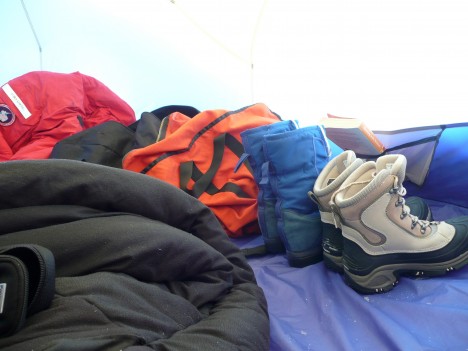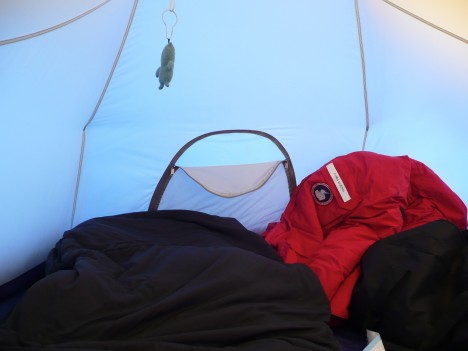

By Lora Koenig
Byrd Station (Antarctica), 12 December —The traverse team left yesterday and made it to Camp 1, 95 kilometers (59 miles) away. I spoke with Michelle last night; they had a few problems yesterday. One was that some bolts on the bottom of the radar sled came loose and the sled started to detach from one of the snowboards that serves as the sled runner. Ludo saw this early in the traverse (3 km, or 1.8 mi, out) and he and Clem fixed the sled with the spare parts kit. They used up all of the spare bolts to fix it. Last night, Michelle and Randy relayed the specifics of the bolts to me and I asked the Byrd mechanic, Paul, if he had any bolts to spare. He did. I added the bolts to the cache list.
The radar team had one additional problem. At some point, with all of the bumping of the sled, the GPS became unplugged. Without the GPS running we cannot tell where the radar data was taken. Ludo and Clem figured out that they had lost about 25 km (15.5 mi) of data. So they turned around, went back and recollected the data. They drove over 140 km (87 mi) yesterday! A huge day. Spirits were high and all was well at SEAT Camp 1 last night.
This morning I woke up at Byrd to patches of blue skies. The pilots told me that we would put in the caches if the weather was good enough for flying, so I jumped out of my sleeping bag ready to go. Also, if the weather held, I would catch a late night flight out of Byrd to McMurdo. I quickly packed my sleep kit and duffle so I would be ready to leave if a plane came. I went to the communications tent to talk with the pilots. At 7 AM they were already loading our 55-gallon drums of fuel in the DC-3 Bassler plane, so I knew we were going to try and put in the caches.
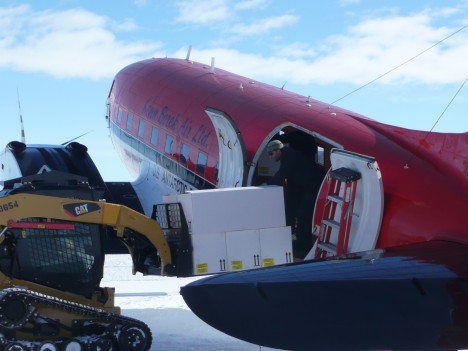
I made a quick stop in the galley on the way to the plane to see if they had any treats I could add to the caches. They gave me a loaf of bread and some home-baked chocolate chip cookies that I tucked into my backpack along with some Snickers bars, teas and letters for the team.
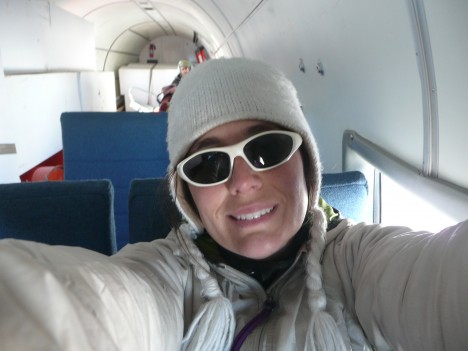
The Bassler took off just before 8 AM. At 8:15 we flew over the traverse team at SEAT Camp 1. I was up in the cockpit so I could see better. Everyone —Michelle, Jessica, Randy, Clem and Ludo— came out of the tents to wave at the plane and the copilot, who was flying the plane at the time, dipped a wing to wave hello. About 15 minutes later, the pilots started looking for a site to land and drop the first cache. The original GPS location did not have good surface definition so we landed about2 km (1.2 mi) away from the planned camp site. I left the bolts, bread, a note and an ice core box for the team.
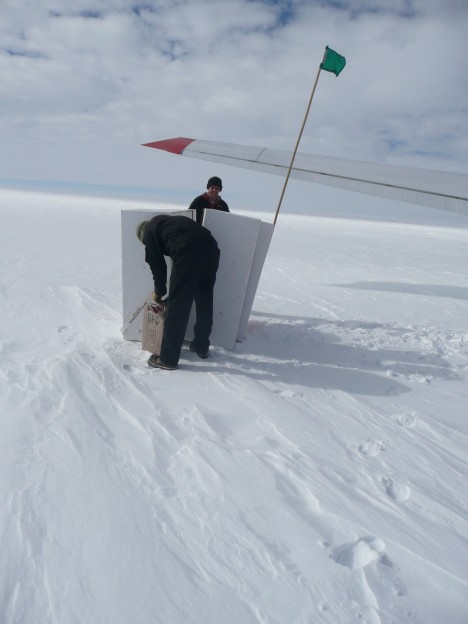
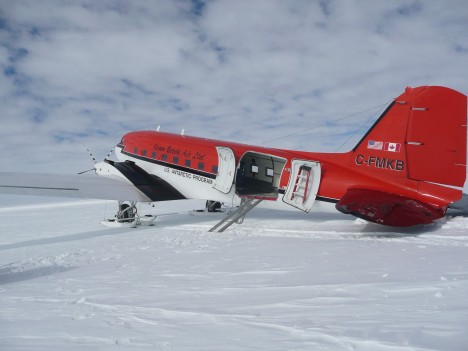
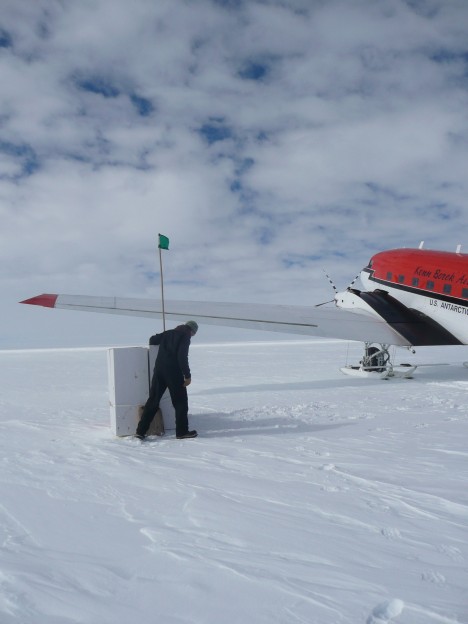
We continued to take off and land at each of the five cache sites. We were able to land exactly at the location of three of the five cache site and at two of the sites the team will have to snowmobile out to retrieve the caches. The caching went fast and took just over 2 hours. At each site, the team will get more premix and mogas, ice core boxes, and a surprise: At the first site, bread; at the second, cookies; at the third, crackers and stickers; at the forth Snickers bars and a Christmas card; and at the fifth, hot chocolate and tea. I told Michelle that I had left a letter at each site but they have no idea that they have gifts too. I hope they enjoy their surprises.
Along the route, I watched the surface carefully. I was looking for sastrugi (wind-blown snow dunes) that could slow the team’s progress, as well as for crevasses. We had already looked at the satellite imagery for crevasses, but it is always good to look with your own eyes. The surface conditions over the route were very smooth (though that could change with a big storm), and there were no crevasses.
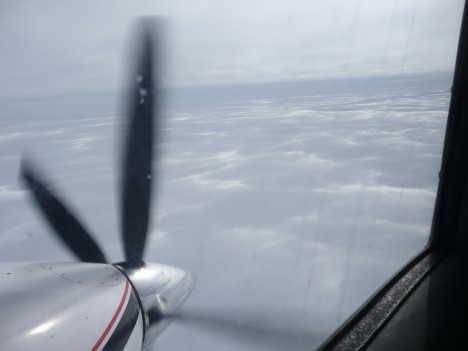
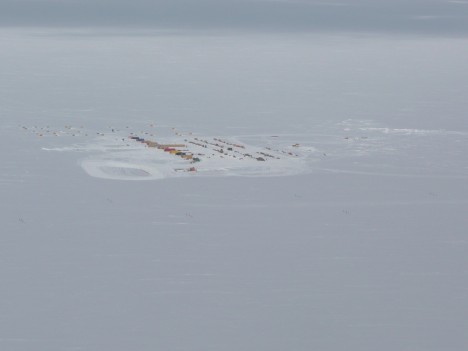
When we returned to Byrd, I needed to relay the cache positions to the team. I called Mac Ops (McMurdo Operations), where the team checks in everyday. Michelle knew to check-in in the evening to get the cache coordinates. I gave Mac Ops the cache locations and left a message for Michelle to call Byrd Camp for more information on the route conditions. Since I was expecting to get a flight out that afternoon I left detailed notes with the Byrd Camp manager, Kaija.
In the early afternoon, a fog bank came in over Byrd Camp and I knew I would not be leaving today. I spent the afternoon digging out fuel bladder to help contribute to camp choirs. There is always a lot of work to be done at field camps. At 9 PM I answered the call from Michelle to Byrd Camp. She was surprised to hear my voice. I told her about the route and she told me they had completed drilling the ice core at Camp 1. They plan on traveling to Camp 2 tomorrow. Great progress! The team is happy and excited to be making such good time. We are all happy that the caches are in so they can complete their work without worrying about getting good enough weather for a plane to fly.

I am now just waiting for a plane to arrive so I can get home. I am over a week delayed getting back. The good thing is that the traverse team has made up time at both Byrd and Camp 1 and are almost back on schedule after the delays in McMurdo.
Other news from Byrd Camp is that the camp population was very small last night. After the Bassler cached our supplies it took off to fly for Polenet, another science team at Byrd putting out seismometers and GPS stations. The Bassler could not return to Byrd due to fog that rolled in, and it had to divert to WAIS Divide camp, so about eight people are staying there for the night.
Here’s hoping for better weather tomorrow though the forecast does not look good.
By Lora Koenig
Byrd Station (Antarctica), 11 December — We all got up at 5 AM this morning. I had gone to bed at 2 am because I had been backing up all of the radar data, which took much longer than anticipated. The traverse team went to bed early to be rested for the day.
It was a beautiful morning: warm, no wind, with thin, low, overcast clouds. The sleds were loaded and ready to go, already hooked on to the snowmobiles. Ludo was the first to the sleds and he started the generator, which powers heating pads that are used to warm the radars after being cold soaked all night. After about 15 minutes of warming, the radars can be started. During this time, the GPS is also turned on so it can obtain lock with the satellites and provide accurate positions.
I took the snowmobile covers off and helped Michelle load the final sleep kits on the sleds. The sleep kits are the last things to be loaded and contain a sleeping bag, sleeping bag liner, insolite pad, thermorest, pillow (if you want one, though most of us prefer to just use big red as a pillow), and a pee bottle so you don’t have to leave the tent in the middle of a cold night or storm. All of this is stuffed into a duffle bag and goes with you everywhere inAntarctica.
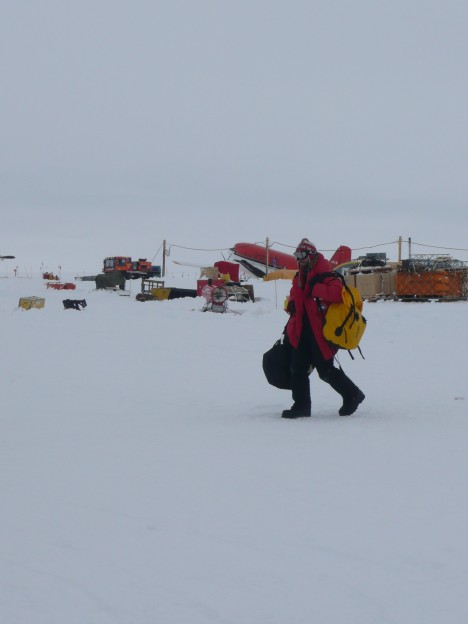
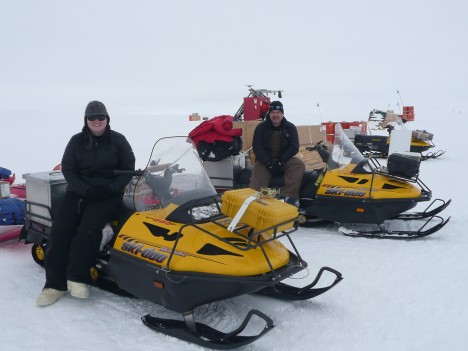
Once the generator was started, the team headed into the galley for a quick breakfast. Most of the camp was still asleep because Sunday is their day off; however, Kaija and Tony, the camp manager and assistant manager, came up to see the team off. After breakfast, the radars were turned on and the snowmobiles started. We took some final pictures and I tried to shoot some video but the small video camera we brought along is not operating well in the cold. The feeling of both excitement and nervousness was in the air. Excitement for finally getting to the traverse portion of the science and nervousness because the team is headed out into the remoteness ofAntarcticaalone. They will no longer have the security of an established camp and will have to rely on each other for everything. The team is strong and I know they will do well. During the traverse they will most certainly cover ground that no human has ever walked on before.
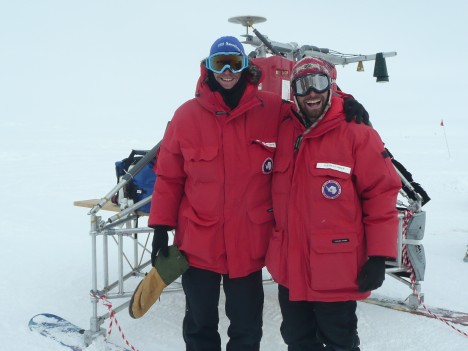
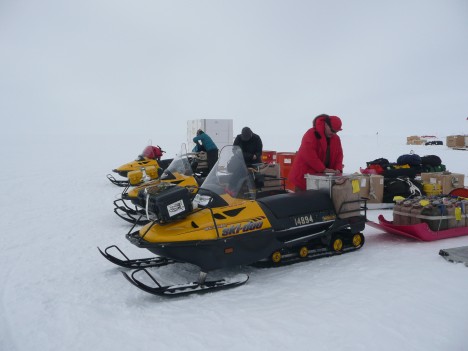
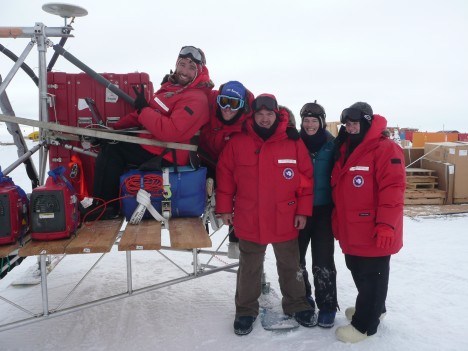
At 6:41 AM, Michelle led the team out of Byrd Camp. She pulled a Siglin sled and a Nansen sled with food, the Scott tent, an HF radio for emergency communication, the radar spare parts, the sleep kits and personal gear. Michelle rides one of the two snowmobiles with mirrors so she can easily watch the team. Jessica followed pulling 2 Siglin sleds with food, the ice core drill and two ice core boxes. Randy was third in line with two Siglin sleds with even more food, the mountain tents, emergency bag, and all of the fuel. Ludo pulled the final snowmobile out and into line pulling the radar sled with Clem on the sled operating the radar. We all screamed and waved as they pulled away.
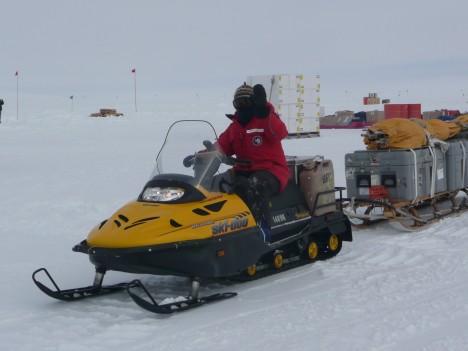
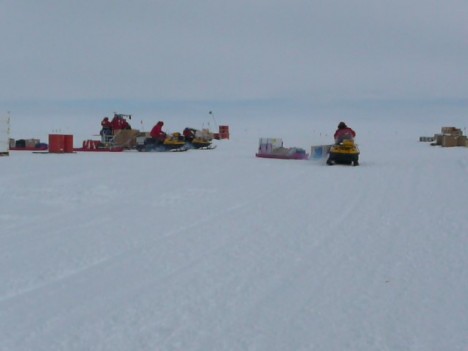

I continued to watch as they moved further towards the horizon. They became smaller and smaller dots on the horizon above tent city as they moved away from camp. At 7:12 AM their dots blurred into the horizon. The traverse had begun.

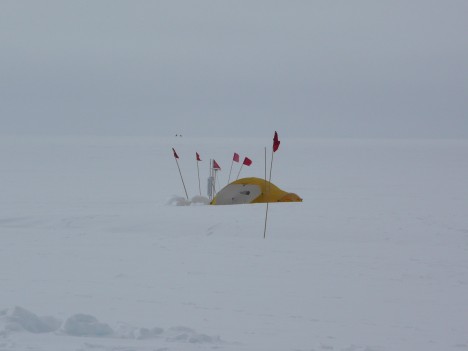
They will travel 95 km (59 mi) today, their longest stretch of the entire traverse, to the first camp site. They are moving toward higher snow accumulation and towards WAIS Divide field camp. When they reach the site tonight, they will be95 km(59 mi) from Byrd and85 km(52.8 mi) from WAIS Divide, so if they have any problems they will head to WAIS Divide, not Byrd.
I am feeling very lonely sitting in Byrd camp without the team, but there is still important work to do. Remember, the team still does not have their fuel caches. The pilots are in camp, but today’s overcast weather, while great for traversing, is not adequate for flying: The clouds make it difficult to see the snow surface. The pilots call this surface definition. In order to do open field landings (landings not on a ski way), the pilots cannot have overcast clouds at any level. Now I am just waiting for the weather to clear so that the plane can cache the team’s fuel and ice core boxes. I am also waiting for an LC-130 to come into Byrd so I can get a ride back to McMurdo and then back to the U.S.
Today I will also check the base station GPS and give a science lecture about our traverse to the Byrd Camp residents.
Everyone at Byrd Camp has helped us so we can complete our science goals and it is much appreciated. Thank you, Byrd Camp! We especially enjoyed the wonderful food made by Chef Rob. The team’s send-off dinner was duck with a port sauce, chicken with polenta, pureed carrots, broccoli with hollandaise sauce, and Boston Cream and Lemon Meringue pie for dessert. Yummmmm!
Around 7 PM tonight I expect to get a satellite phone call from Michelle. From this point on, the blog will have less pictures for a while because we will only have voice communication with the team. It should take between 24 and 30 days to complete the traverse, including (bad) weather days. The team will communicate back to me at each camp site and I will update you on their progress. When they return, we will post more posts from them with pictures of the traverse.
The team is truly out in the wilderness. The only communication they have is through the sat phone, which will only be on for a few hours in the evening. They can call their families and their families can send 160 character text messages to the sat phone. The deep field ofAntarcticais a remote place.
Go team, go!!!!!! (The extra exclamation points are for Clem, who loves to use them.)
By Bob Bindschadler
McMurdo (Antarctica), 14 December — (Warning: this entry is not for the weak of heart.) Woe is me. A logistics scourge seems to have befallen our project. The past two days have been filled with nothing but bad news. The traverse from Byrd to PIG not only has continued to encounter soft snow, but the transmission on one tractor has failed, and a hydraulic line on another one has a leak that has stopped it literally in its tracks. Much of the cargo being hauled by the tractors is loaded on sheets of very slippery, but strong, plastic. Well, maybe not so strong, after all: This is the second season these sheets have been used and they are starting to crack and break, forcing the traverse party to stop, jigger the load around and then start up again. All this leaves me with the mental image of bits of the traverse littering the trail from Byrd to PIG. Still, the traverse people press onward, with fewer vehicles and less cargo. Their estimate is to arrive at PIG on Friday, but unless they cover more than the 20 miles they’ve completed each of the past two days, it will take yet longer.
The flying side is not going much better. Bad weather continues to plague both of the possible refueling stops so the put-in flight has been cancelled every morning. The weather is forecast to improve at those sites, both of them in the interior of West Antarctica, but (you guessed it) weather at PIG is deteriorating now. We in the field party marooned in McMurdo test our mental mettle by checking a couple of web sites that allow us to view the weather forecasts for the key stations involved in this effort, as well as David Holland’s web cam, which remains our lone virtual presence at PIG. It hurts to see sunny skies there and not be able to fly a plane there.
If this was a football game, the cargo managers would receive a penalty for “piling on”. Yesterday we had a meeting where we heard that our cargo was not the 9,000 pounds that we had planned, but rather 15,000 pounds, necessitating an additional flight to PIG (#9, if you are keeping count). We were only slightly surprised, because I saw this coming. In fact, I was the one who asked for the meeting so we could address any problem early. As I explained in my previous post, we’ve had to add a number of items to our cargo line due to less being taken by the traverse. Also, our colleague Sridhar Anandakrishnan was sent to his early season work site without the skidoos he was supposed to use there, so we have to bring them to PIG via another route. I felt it was time to push back on the size and design of the PIG Main Camp. I said we would lower the priority of some limited parts of our project, so they could arrive on this later flight, but I couldn’t shed all of the 6,000-pound extra cargo. I insisted on some sacrifices from the Main Camp. The head of construction there offered to consider downsizing some of the plumbing (!) and electrical components of the camp. Most others didn’t offer much. If the Herc pilots like the runway when they get to PIG, they might increase the allowed cargo limit (ACL) of subsequent flights, so this problem might go away, but this strikes me as wishful thinking. Nevertheless, I’ll be meeting with the head of the LC-130 squadron to discuss the benefits of even a 500-pound increase of the ACL. Exploring every possible way of getting us to PIG sooner is what my job here has become.
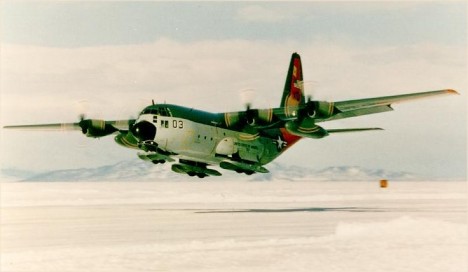
In that vein, I’ve come up with yet another strategy to recover some lost time. It involves having a Twin Otter airplane attempt a landing at our intended drill camp location on the ice shelf. This is a bit of déjà vu because three years ago I landed on the ice shelf in a Twin Otter only to be told the surface was too hard and rough for repeated landings. Some super high-resolution satellite imagery suggests to us the result might be different at this new site, so I want to try it again.

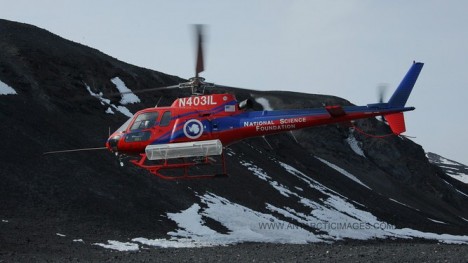
I’ve had to write to my program manager back in DC to ask that he supports this request. I made the case that, if successful, we could get the drill camp up and running before helos arrive and are operational at PIG Main Camp. We still have work to do that only the helicopters can support, but we are feeling the increased time pressure of time and splitting the support load would definitely help. It could also eliminate the need for any helicopters next season if we can complete the helo-only work this year and the drilling can be supported by Twin Otters. I delivered my sales pitch to the Twin Otter pilots after lunch today, and I’ll hear from NSF back in DC tomorrow.
On the bright side, I have plenty to restore a balanced perspective. Today is the 100th anniversary of Roald Amundsen’s arrival at the South Pole. As everyone surely knows, Robert Falcon Scott and his field party reached the same spot a month later, but perished on the return journey. I am not about to set out to ski/man haul our cargo to PIG, nor I expect to suffer the extraordinary hardships of either Scott or Amundsen. Antarctic science nowadays is usually hard, often frustrating, but it is rarely life threatening. I’ll take that as some much needed good news.
By Bob Bindschadler
McMurdo (Antarctica), 12 December — Well, nearly a week has whizzed by. We have been quite busy, but it doesn’t feel like there’s been much real progress. Every day seems to come with its own set of new problems and developments. This includes cargo hunting (yes, it was still going on until recently—but it’s DONE now), remembering some item or tool that would probably prove useful (then finding it and getting it) or thinking of some small thing to build and then getting the carpenters or machinists to understand what we want, (then waiting for the item, packing it and getting it into the cargo system.)
Tying up these loose ends didn’t add much weight to our overall cargo load, but we knew we were going to be heavier than we had planned for because there were some heavy items that failed to make it on flights to Byrd Station, where the over snow traverse was going to be taking them to the main camp at Pine Island. These problems originated way back in early September: Early season weather in West Antarctica was worse than usual, which meant fewer flights to Byrd and less of our cargo getting there when the traverse needed to start. Without sufficient cargo, the traverse managers held their departure back a few days. When they tried to start, one of the large tractors failed, leaving them with only three. This actually worked out better, since there was less cargo to pull. Now we hear that the traverse is encountering soft snow, slowing its progress even more. The image below is a map of the traverse’s progress through last night. It’s averaging less than 4.5 miles per hour and under 60 miles per day: At this rate, it will be another five days before it arrives at PIG.
It’s a polar tortoise and hare race. The traverse is undoubtedly the tortoise, but the hare is having its own difficulties. Flights to PIG take “only” 5 hours (one-way) and were scheduled every day since Wednesday last week (except Sunday). Each one of them was cancelled because of bad weather at one or more of the required landing spots: McMurdo, Byrd or PIG. Good weather at Byrd is necessary to refuel the plane on its way home. Today’s weather looked the best of all days and, unlike last week’s flights, the plane actually took off from McMurdo. But two hours into the 5-hour flight, the weather went bad at Byrd. WAIS is another nearby station that could refuel the aircraft, but weather also went bad in there not long after. So the plane was ordered back to McMurdo before it was so far away and had so little fuel that it would get stuck somewhere out in the middle of West Antarctica.
It’s anybody’s guess who will get to PIG first: the traverse or the put-in flight. The traverse is more important, because it has the heavy equipment to dig out all the camp material left there at the end of last season (a small camp was set up then), groom the runway used last season (if the flags marking it can be found, that is) and tap into the all-important fuel bladder. Getting to that fuel is key because with it the LC-130 cargo planes (called “Hercules” or “Hercs”, for short) can get enough fuel to get back to McMurdo without having to stop at Byrd or WAIS. This will make missions to PIG less susceptible to weather cancellations.
Our cargo handling is done. But, as I mentioned, since now we have to fly some items that didn’t get to Byrd by the traverse’s departure, our stuff weighs more than planned. Whether that requires another flight will not be decided until we hear if the groomed runway at PIG can handle heavier landing weights. It’s all connected: cargo, tractors, fuel, airplanes and weather. Meanwhile, we will make our case for moving our necessary science cargo up in the queue, so we don’t suffer more delays.
It’s not all bad news. These past few days have contained some bright spots. Our project has received a lot of attention. A Blue Ribbon Panel, here last week to assess the effectiveness of the US Antarctic Program, really likes the social relevance of our mission and its interdisciplinary character. I gave a science lecture on PIG to a packed audience and got superb reviews. Many people here have touched the project in one way or another and I wanted them to understand what it was about and why we have to go to someplace that is so hard to get to. I also was singled out to prepare a poster and speak to the Prime Minister of Norway, who is flying to the South Pole to mark the 100th anniversary of Roald Amundsen’s trip.
Attention is great; more progress would be even better!
By Lora Koenig
Byrd Camp (Antarctica), December 7 — At 4:45 PM today we boarded another Delta for a ride to Pegasus field. The last weather report we had for Byrd Camp was for half-mile visibility and 40-knot winds with blowing snow. The conditions were predicted to continue to deteriorate, so I expected the flight to be canceled. When we arrived Pegasus we saw our gear being loaded on an LC-130 flown by the 109th Air Wing. We also saw a plane taxiing to the skiway that was headed to WAIS Divide camp, which is about 100 kilometers (62 miles) from Byrd. So when we say that plane take off, we knew we had a good chance of getting into Byrd.
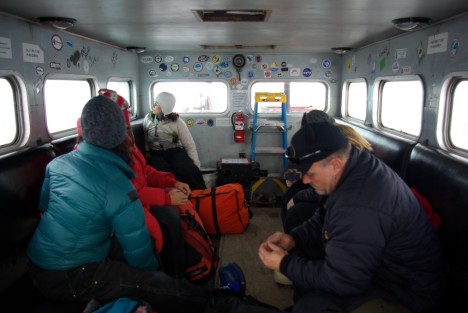
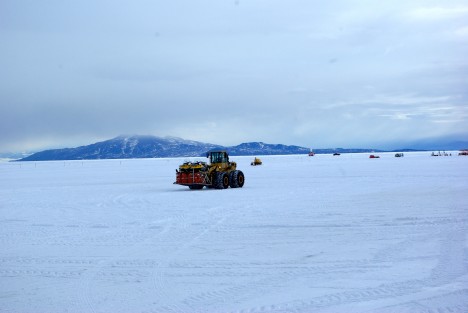
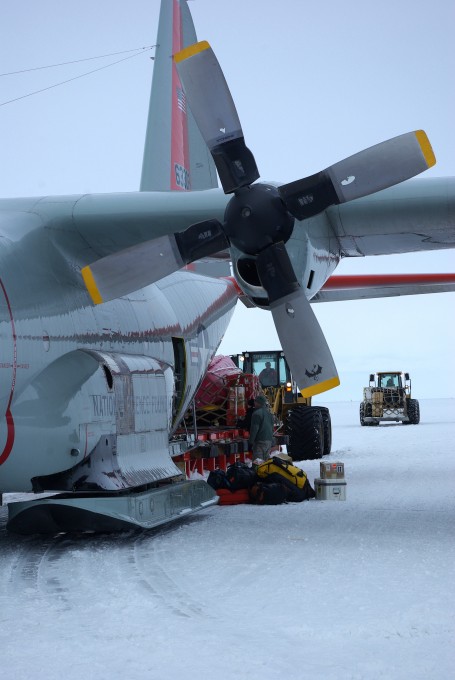
We took off at around 8 PM for the 3-hour flight to Byrd. Jessica got to ride in the cockpit for take-off. During the flight, we looked out the windows into clouds for most of the time, but at one point the Ross Ice Shelf was visible and we saw a large crack in the ice shelf, which was exciting to see though I do not know anything about the science behind it. I will ask and expert in a few weeks and get back to you with more information about the crack.
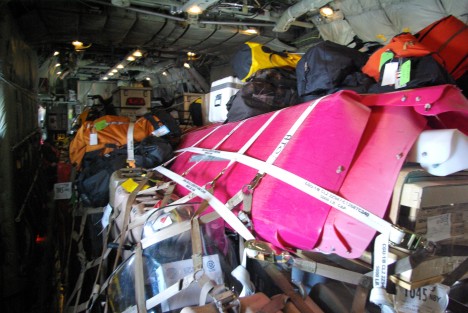
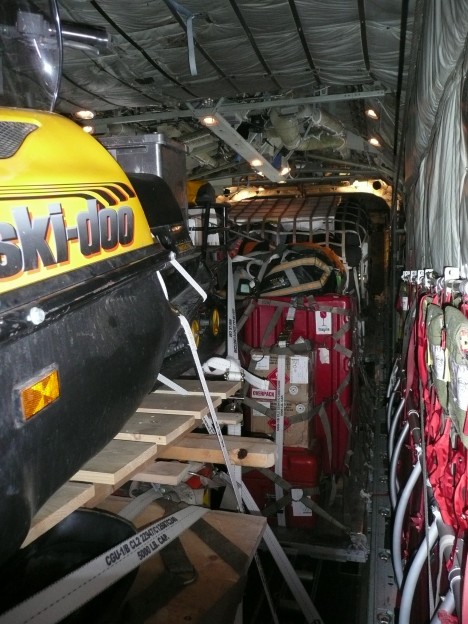
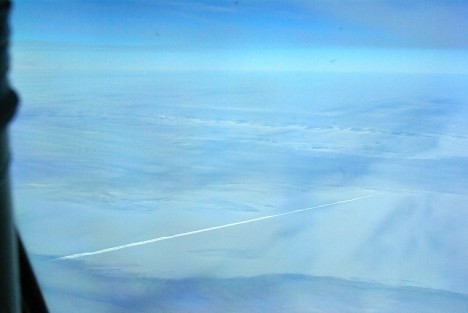

We arrived Byrd Camp around 11:00 PM. After we landed, all of our cargo was combat off-loaded. A combat off-load is when they open the back of the LC-130 and send the palettes out the back with a swift kick and a sudden acceleration of the plane. This method is very rough on our gear and we will have to double-check everything again to make sure nothing is broken. One of my constant reminders to the team is, “Don’t break anything”: We have to fix anything we break and we may not have the parts. So combat off-loading of gear makes me very nervous, but we didn’t have any other choice. And it is actually really fun to see the combat off-loads if you forget that it is your gear.
Here are some pictures of the combat off-load:
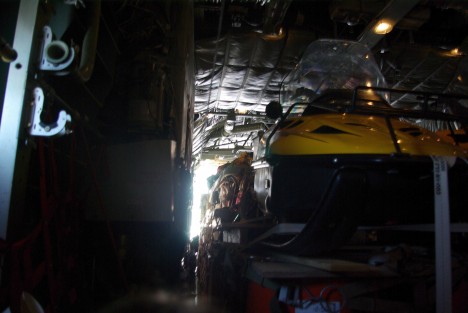
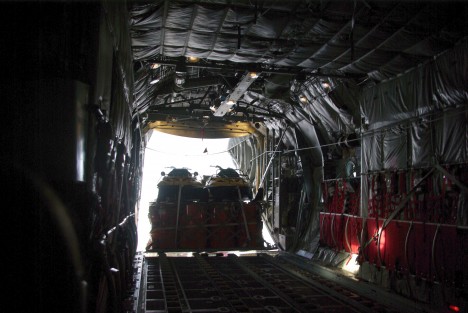
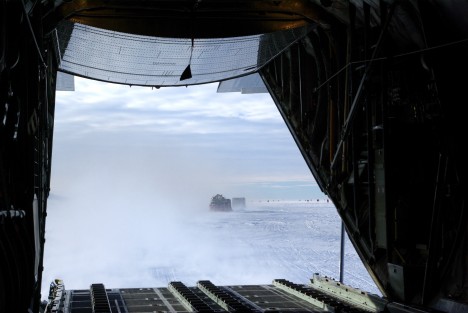
Here is a picture of the team finally in the field.
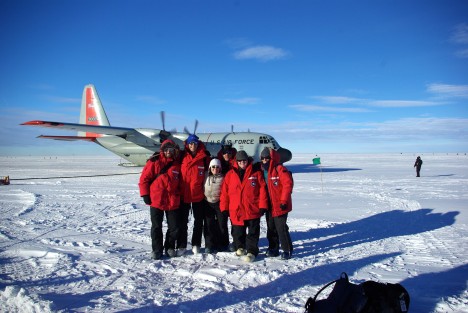
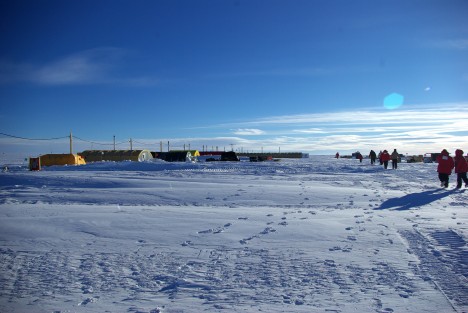
We had a quick tour of Byrd Camp and then went to tent city to our tents to sleep for the night. I was warm all night but others were a bit cold on their first night in their tents. We are finally ready to start the science!

